Lavender Is a Member of What Plant Family?
| Lavender | |
|---|---|
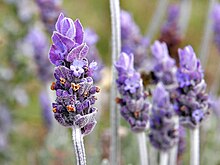 | |
| Lavender flowers with bracts | |
| Scientific nomenclature | |
| Kingdom: | Plantae |
| Clade: | Tracheophytes |
| Clade: | Angiosperms |
| Clade: | Eudicots |
| Clade: | Asterids |
| Order: | Lamiales |
| Family: | Lamiaceae |
| Subfamily: | Nepetoideae |
| Tribe: | Ocimeae |
| Genus: | Lavandula L. |
| Type species | |
| Lavandula spica 50. | |
| Synonyms[1] | |
| |
Lavandula (common name lavender) is a genus of 47 known species of flowering plants in the mint family unit, Lamiaceae. Information technology is native to the Old World and is found in Cape Verde and the Canary Islands, and from Europe across to northern and eastern Africa, the Mediterranean, western asia to India.[2]
Many members of the genus are cultivated extensively in temperate climates every bit ornamental plants for garden and landscape apply, for use as culinary herbs, and also commercially for the extraction of essential oils.[three] The most widely cultivated species, Lavandula angustifolia, is often referred to as lavender, and there is a color named for the shade of the flowers of this species. Lavander has been used over centuries in traditional medicine and cosmetics, and "limited clinical trials support therapeutic use of lavender for pain, hot flushes, and postnatal perineal discomfort."[4] [v]
Description [edit]
The genus includes annual or short-lived herbaceous perennial plants, and shrub-like perennials, subshrubs or small shrubs.[6]
Leaf shape is diverse across the genus. They are elementary in some normally cultivated species; in other species, they are pinnately toothed, or pinnate, sometimes multiple pinnate and dissected. In about species the leaves are covered in fine hairs or indumentum, which unremarkably contain the essential oils.[6]
Flowers are borne in whorls, held on spikes rising above the foliage, the spikes being branched in some species. Some species produce colored bracts at the tips of the inflorescences. The flowers may be blue, violet or lilac in the wild species, occasionally blackish purple or yellowish. The calyx is tubular. The corolla is also tubular, unremarkably with five lobes (the upper lip frequently scissure, and the lower lip has two clefts).[6] [seven]
Classification and taxonomy [edit]
Lavandula stoechas, L. pedunculata, and L. dentata were known in Roman times.[8] From the Center Ages onwards, the European species were considered 2 separate groups or genera, Stoechas (50. stoechas, Fifty. pedunculata, Fifty. dentata) and Lavandula (L. spica and L. latifolia), until Linnaeus combined them. He only recognised five species in Species Plantarum (1753), L. multifida and Fifty. dentata (Spain) and 50. stoechas and L. spica from Southern Europe. L. pedunculata was included inside L. stoechas.
Past 1790, Fifty. pinnata and L. carnosa were recognised. The latter was subsequently transferred to Anisochilus. Past 1826 Frédéric Charles Jean Gingins de la Sarraz listed 12 species in 3 sections, and past 1848 eighteen species were known.[eight]
I of the first modern major classifications was that of Dorothy Chaytor in 1937 at Kew. The 6 sections she proposed for 28 species all the same left many intermediates that could not easily be assigned. Her sections included Stoechas, Spica, Subnudae, Pterostoechas, Chaetostachys, and Dentatae. All the same all the major cultivated and commercial forms resided in the Stoechas and Spica sections. There were four species within Stoechas (Lavandula stoechas, L. dentata, L. viridis, and L. pedunculata) while Spica had 3 (L. officinalis (now Fifty. angustifolia), L. latifolia and L. lanata). She believed that the garden varieties were hybrids between true lavander L. angustifolia and spike lavender (L. latifolia). [ix]
Lavandula has three subgenera:[ citation needed ]
- Subgenus Lavandula is mainly of woody shrubs with unabridged leaves. It contains the principal species grown as ornamental plants and for oils. They are found beyond the Mediterranean region to northeast Africa and western Arabia.
- Subgenus Fabricia consists of shrubs and herbs, and it has a broad distribution from the Atlantic to India. It contains some ornamental plants.
- Subgenus Sabaudia constitutes two species in the southwest Arabian peninsula and Eritrea, which are rather distinct from the other species, and are sometimes placed in their own genus Sabaudia.
In add-on, in that location are numerous hybrids and cultivars in commercial and horticultural usage.[6]
The start major clade corresponds to subgenus Lavandula, and the second Fabricia. The Sabaudia group is less conspicuously defined. Inside the Lavandula clade, the subclades correspond to the existing sections, merely place Dentatae separately from Stoechas, non within it. Within the Fabricia clade, the subclades correspond to Pterostoechas, Subnudae, and Chaetostachys.
Thus the current classification includes 39 species distributed beyond viii sections (the original vi of Chaytor and the 2 new sections of Upson and Andrews), in 3 subgenera (see table below). Yet, since lavander cross-pollinates hands, countless variations present difficulties in classification.
Etymology [edit]
The English discussion lavender is generally thought to be derived from Old French lavandre, ultimately from the Latin lavare (to wash), referring to the utilise of infusions of the plants.[x] The botanic proper noun Lavandula every bit used past Linnaeus is considered to be derived from this and other European colloquial names for the plants. However it is suggested that this explanation may be apocryphal, and that the name may be derived from Latin livere, "blueish".[xi]
The names widely used for some of the species, "English lavender", "French lavender" and "Spanish lavender" are all imprecisely applied. "English lavender" is normally used for L. angustifolia, though some references say the proper term is "Old English Lavander".[12] The name "French lavender" may refer to either 50. stoechas or to L. dentata. "Castilian lavender" may refer to L. stoechas, 50. lanata or L. dentata.
Cultivation [edit]

The near common form in tillage is the common or English lavender Lavandula angustifolia (formerly named L. officinalis). A wide range of cultivars can exist found. Other usually grown ornamental species are L. stoechas, Fifty. dentata, and L. multifida (Egyptian lavender).
Considering the cultivated forms are planted in gardens worldwide, they are occasionally constitute growing wild as garden escapes, well beyond their natural range. Such spontaneous growth is usually harmless, but in some cases Lavandula species have become invasive. For example, in Commonwealth of australia, Lavandula stoechas has go a crusade for business organisation; it occurs widely throughout the continent, and has been alleged a noxious weed in Victoria since 1920.[13] It is regarded as a weed in parts of Spain.[14]
Lavenders flourish best in dry, well-drained, sandy or gravelly soils in full sun.[15] English Lavender has a long germination process (xiv–28 days) and matures within 100–110 days.[16] All types demand little or no fertilizer and good air circulation. In areas of high humidity, root rot due to mucus infection tin be a problem. Organic mulches can trap moisture around the plants' bases, encouraging root rot. Gravelly materials such as crushed rocks give better results.[17] It grows best in soils with a pH between half dozen and viii.[18] Almost lavender is hand-harvested, and harvest times vary depending on intended utilise.[eighteen]
Lavender oil [edit]
Commercially, the plant is grown mainly for the production of lavander essential oil of lavender. English lavander (Lavandula angustifolia) yields an oil with sweet overtones, and tin can be used in balms, salves, perfumes, cosmetics, and topical applications.[4] Lavandula × intermedia, also known equally lavandin or Dutch lavender, yields a similar essential oil, but with higher levels of terpenes including camphor, which add a sharper overtone to the fragrance.
The lavandins Lavandula × intermedia are a grade of hybrids of L. angustifolia and 50. latifolia.[19] The lavandins are widely cultivated for commercial use, since their flowers tend to be bigger than those of English lavander and the plants tend to be easier to harvest, but lavandin oil is regarded by some to exist of a lower quality than that of English lavender, with a perfume less sweetness.[twenty]
The United states Food and Drug Assistants considers lavender as more often than not recognized as safe (GRAS) for human consumption.[21] The essential oil was used in hospitals during Earth War I.[15]
Phytochemicals [edit]
Some 100 individual phytochemicals have been extracted from lavender oil, including major contents of linalyl acetate (xxx-55%), linalool (20-35%), tannins (5-10%), and caryophyllene (8%), with lesser amounts of sesquiterpenoids, perillyl alcohols, esters, oxides, ketones, cineole, camphor, beta-ocimene, limonene, caproic acid, and caryophyllene oxide.[4] [21] [22] The relative amounts of these compounds vary considerably among lavender species.[four]
Culinary use [edit]

Lavender-flavored cupcakes
Culinary lavender is usually English language lavander, the nearly normally used species in cooking (L. angustifolia 'Munstead'). Equally an effluvious, it has a sweet fragrance with lemon or citrus notes.[23] It is used every bit a spice or additive in pastas, salads and dressings, and desserts.[24] [25] Their buds and greens are used in teas, and their buds, processed by bees, are the essential ingredient of monofloral honey.[26]
Employ of buds [edit]
For most cooking applications the dried buds, which are besides referred to equally flowers, are used. Lavender greens have a more subtle season when compared to rosemary.[27]
The potency of the lavander flowers increases with drying which necessitates more than sparing use to avert a heavy, soapy palatableness. Chefs note to reduce past 2-thirds the dry out amount in recipes which call for fresh lavander buds.[23] [28] [ better source needed ]
Lavender buds can dilate both sugariness and savory flavors in dishes, and are sometimes paired with sheep'due south-milk and goat'southward-milk cheeses. Lavender flowers are occasionally blended with black, green, or herbal teas. Lavander flavors baked goods and desserts, pairing specially well with chocolate. In the United States, both lavander syrup and dried lavender buds are used to make lavender scones and marshmallows.[29] [30]
Lavender buds are put into sugar for two weeks to allow the essential oils and fragrance to transfer; then the sugar itself is used in baking. Lavender can be used in breads where recipes call for rosemary. Lavander can be used decoratively in dishes or spirits, or as a decorative and aromatic in a glass of champagne. Lavender is used in savory dishes, giving stews and reduced sauces aromatic flair. It is likewise used to aroma flans, custards, and sorbets.[23]
Apply of greens [edit]
The greens are used similarly to rosemary or combined with rosemary to season meat and vegetables in savory dishes. They can likewise exist used to make a tea that is milder than teas made with the flowers.[31]
In honey [edit]
The flowers yield abundant nectar, from which bees make a high-quality honey. Monofloral honey is produced primarily around the Mediterranean, and is marketed worldwide as a premium product. Flowers can be candy-coated and are sometimes used as cake decorations. It is likewise used to make "lavender saccharide".[26]
Other uses [edit]

Flower spikes are used for dried flower arrangements. The fragrant, pale purple flowers and blossom buds are used in potpourris. Lavender is also used every bit herbal filler inside sachets used to freshen linens. Stale and sealed in pouches, lavender flowers are placed among stored items of wear to give a fresh fragrance and to deter moths.[32] Dried lavender flowers may be used for wedding confetti. Lavender is also used in scented waters and sachets.
In history and culture [edit]
The aboriginal Greeks chosen the lavender herb νάρδος : nárdos, Latinized as nardus, subsequently the Syrian city of Naarda (perhaps the modern town of Dohuk, Republic of iraq). Information technology was besides commonly chosen nard.[33] The species originally grown was L. stoechas.[6]
During Roman times, flowers were sold for 100 denarii per pound, which was about the same every bit a calendar month's wages for a farm laborer, or fifty haircuts from the local barber. Its late Latin name was lavandārius, from lavanda (things to be done), from the verb lavāre (to launder).[34]
Culinary history [edit]
Spanish nard (Erstwhile French: "spykenard de spayn le pays"), referring to L. stoechas, is listed as an ingredient in making a spiced wine, namely hippocras, in The Forme of Cury.[35]
Lavender was introduced into England in the 1600s. It is said that Queen Elizabeth prized a lavender conserve (jam) at her table, so lavender was produced as a jam at that fourth dimension, as well as used in teas both medicinally and for its sense of taste.[23]
Lavender was not used in traditional southern French cooking at the turn of the 20th century. It does not appear at all in the all-time-known compendium of Provençal cooking, J.-B. Reboul's Cuisinière Provençale.[36] French lambs have been allowed to graze on lavender as it is alleged to make their meat more tender and fragrant.[23] In the 1970s, a blend of herbs chosen herbes de Provence was invented by spice wholesalers. Culinary lavander is added to the mixture in the Northward American version.[37]
In the 21st century, lavender is used in many world regions to flavor tea, vinegar, jellies, broiled goods, and beverages.[38]
Enquiry [edit]

Bunches of lavender for auction, intended to repel insects
Most preliminary clinical studies on the potential for lavender oil or other lavender plant components to affect homo diseases have yet to confirm anti-illness or wellness effects as of 2018, largely due to the poor quality of study pattern and behave.[four] [5] Limited clinical trials support therapeutic utilize of lavender for pain, hot flushes, and postnatal perineal discomfort.[ medical citation needed ]
Lavender oil has been studied by preliminary research for its possible effect in alleviating anxiety and slumber disturbances,[39] merely no conclusions about the effects on anxiety were possible.[forty]
Herbalism [edit]
The German language scientific committee on traditional medicine, Commission Due east, reported uses of lavander flower in practices of herbalism, including its use for restlessness or insomnia, Roehmheld's syndrome, intestinal discomfort, and cardiovascular diseases, among others.[41]
Health precautions [edit]
The U.S. National Institutes of Health (NIH) states that lavender is considered likely safe in food amounts and may be safe for medicinal purposes such as anxiety.[5] NIH does non recommend the use of lavender while pregnant or chest-feeding because of lack of noesis of its effects. Information technology recommends caution if young boys apply lavander oil because of possible hormonal effects leading to gynecomastia[42] [43] caused by a genetic anomaly and tainted lavender via pesticides, and states that lavender oil may cause peel irritation and could exist poisonous if consumed by mouth.[five]
A 2007 study examined the relationship betwixt various fragrances and photosensitivity, stating that lavender is known "to elicit cutaneous photo-toxic reactions", simply does not induce photohaemolysis.[44]
Adverse effects [edit]
Some people experience contact dermatitis, allergic eczema, or facial dermatitis from topical use of lavender oil on skin.[4] [5]
Taxonomic table [edit]

This is based on the classification of Upson and Andrews, 2004.
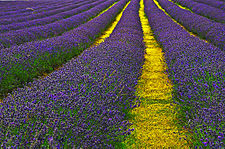

I. Subgenus Lavendula Upson & S.Andrews
- i. Department Lavandula (3 species)
- Lavandula angustifolia Manufactory.
- subsp. angustifolia from Catalonia and the Pyrenees.
- subsp. pyrenaica from southeast France and side by side areas of Italia.
- Lavandula latifolia Medik – native to fundamental Portugal, fundamental and eastern Spain, southern France, northern Italy.
- Lavandula lanata Boiss. – native to southern Spain.
- Hybrids
- Lavandula × chaytorae Upson & S.Andrews (L. angustifolia subsp. angustifolia × L. lanata)
- Lavandula × intermedia Emeric ex Loisel. (L. angustifolia subsp. angustifolia × 50. latifolia)
- 2. Section Dentatae Suarez-Cerv. & Seoane-Camba (1 species)
- Lavandula dentata L. from eastern Espana, northern Algeria and Morocco, southwestern Morocco.
- var. dentata (rosea, albiflora), candicans (persicina) [Batt.]
- iii. Section Stoechas Ging. (iii species)
- Lavandula stoechas L.
- subsp. stoechas from generally coastal regions of eastern Spain, southern France, western Italy, Greece, Bulgaria, Mediterranean Turkey, Levantine coast, and nearly Mediterranean islands.
- subsp. luisieri native to coastal and inland Portugal and adjacent Spain.
- Lavandula pedunculata Mill.(Cav.)
- subsp. pedunculata – Spain and Portugal.
- subsp. cariensis – from western Turkey and southern Bulgaria.
- subsp. atlantica – from montane Morocco.
- subsp. lusitanica – southern Portugal and southwestern Spain.
- subsp. sampaiana – from Portugal and southwest Kingdom of spain.
- Lavandula viridis L'Her. – native to southwest Spain, southern Portugal, and maybe also to Madeira.
- Intersectional hybrids (Dentatae and Lavendula)
- Lavandula × heterophylla Viv. (L. dentata × 50. latifolia )
- Lavandula × allardii
- Lavandula × ginginsii Upson & S.Andrews (L. dentata × L. lanata )
Ii. Subgenus Fabricia (Adams.) Upson & S.Andrews
- iv. Section Pterostoechas Ging. (16 species)
- Lavandula multifida Fifty. – is native to a wide range including Kingdom of morocco, southern Portugal and Kingdom of spain, norther Algeria, Tunisia, Tripolitania, Calabria and Sicily, with isolated populations in the Nile valley.
- Lavandula canariensis Manufactory., from the Canaries.
- subsp. palmensis – from La Palma.
- subsp. hierrensis – from El Hierro.
- subsp. canariensis – from Tenerife.
- subsp. canariae – from Gran Canaria.
- subsp. fuerteventurae – from Fuerteventura.
- subsp. gomerensis – from La Gomera.
- subsp. lancerottensis – from Lanzarote.
- Lavandula minutolii Bolle – Canary Isles.
- subsp. minutolii
- subsp. tenuipinna
- Lavandula bramwellii Upson & S.Andrews – from Gran Canaria.
- Lavandula pinnata 50. – from the Canaries and also Madeira.
- Lavandula buchii Webb & Berthel. – Tenerife.
- Lavandula rotundifolia Benth. – Cape verde Islands.
- Lavandula maroccana Murb. – Atlas mountains of Morocco.
- Lavandula tenuisecta Coss. ex Ball – Atlas mountains in Morocco.
- Lavandula rejdalii Upson & Jury – Morocco.
- Lavandula mairei Humbert – Morocco.
- Lavandula coronopifolia Poir. – This has a wide distribution, from Cape verde across N Africa, the northeast of tropical Africa, Arabia to eastern Iran.
- Lavandula saharica Upson & Jury – southern Algeria and nearby regions.
- Lavandula antineae Maire – central Sahara region.
- subsp. antinae
- subsp. marrana
- subsp. tibestica
- Lavandula pubescens Decne. – from Egypt and Eritrea, Sinai, Israel and Palestine, Jordan, western Arabian peninsula to Yemen.
- Lavandula citriodora A.G. Manufactory. – southwestern Arabian peninsula.
- Hybrids
- Lavandula × christiana Gattef. & Maire (50. pinnata × L. canariensis)
- v. Section Subnudae Chaytor (10 species)
- Lavandula subnuda Benth. – from the mountains of Oman and the United Arab Emirates.
- Lavandula macra Baker – southern Arabian peninsula and Somaliland.
- Lavandula dhofarensis A.G. Mill. – from Dhofar in southern Oman.
- subsp. dhofarensis
- subsp. ayunensis
- Lavandula samhanensis Upson & S.Andrews – Dhofar, Sultanate of oman.
- Lavandula setifera T. Anderson – from coastal regions of Yemen and Somaliland.
- Lavandula qishnensis Upson & Southward.Andrews – southern Yemen.
- Lavandula nimmoi Benth. – from Socotra.
- Lavandula galgalloensis A.1000. Mill. – Somaliland.
- Lavandula aristibracteata A.Chiliad. Mill. – Somaliland.
- Lavandula somaliensis Chaytor – Somaliland.
- half-dozen. Section Chaetostachys Benth. (two species)
- Lavandula bipinnata (Roth) Kuntze – from the Deccan peninsula and key north Republic of india.
- Lavandula gibsonii J. Graham – Western Ghats, India.
- 7. Section Hasikenses Upson & Due south.Andrews (2 species)
- Lavandula hasikensis A.G. Mill. – Oman.
- Lavandula sublepidota Rech. f. – Far, in southern Iran.
III. Subgenus Sabaudia (Buscal. & Muschl.) Upson & South.Andrews
- viii. Section Sabaudia (Buscal. & Muschl.) Upson & S.Andrews (two species)
- Lavandula atriplicifolia Benth. – western Arabian peninsula, Egypt.
- Lavandula erythraeae (Chiov.) Cufod. – from Eritrea.
Gallery [edit]

Lavender growing at Kula Lavender Farm located in Maui, Hawaii
-
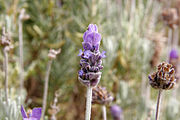
Lavander flower
-

Flower of cultivated lavender; Lavandula stoechas
-
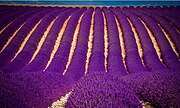
Lavander garden, India
-
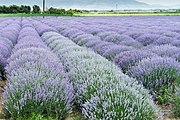
Lavandula fields near Drama
References [edit]
- ^ "Earth Checklist of Selected Plant Families: Royal Botanic Gardens, Kew". kew.org.
- ^ "Outdoor flowering plants - mona lavender". world wide web.hgtv.com. HGTV. Retrieved 19 October 2018.
- ^ "Plant finder - Plectranthus Mona lavender". www.missouribotanicalgarden.org. Missouri Botanical Garden. Retrieved xix October 2018.
- ^ a b c d e f "Lavender". Drugs.com. 1 November 2018. Retrieved 19 August 2021.
- ^ a b c d e "Lavander". National Center for Complementary and Integrative Wellness, US National Institutes of Health. 1 September 2016. Retrieved 15 August 2019.
- ^ a b c d e Upson T, Andrews Due south (2004). The Genus Lavandula. Imperial Botanic Gardens, Kew 2004. ISBN9780881926422 . Retrieved 2012-03-thirty .
- ^ L. H. Bailey. Manual of Cultivated Plants. MacMillan Publishing Company.
- ^ a b Lis-Balchin M, ed. (2002). Lavender: The genus Lavandula . Taylor and Francis. ISBN9780203216521.
- ^ Chaytor D A. A taxonomic study of the genus Lavandula. 1937
- ^ Concise Oxford Dictionary
- ^ The alternative derivation of the name lavender from Latin livere and medieval Latin lavindula is given in Upson and Andrews, where it is presented as a conjecture. The bug with the standard derivation are also described; such as that there is no cognition of the common utilise of lavender for washing by Greeks and Romans.
- ^ Hillier
- ^ Carr, G.W, Yugovic, J.Five and Robinson, Thou.E.. 'Environmental Weed Invasions in Victoria – conservation and direction implications' 1992 Pub: Section of Conservation and Environment and Ecological Horticulture, Victoria, Australia
- ^ Csurches S., Edwards R.; National Weeds Program, Potential Environmental Weeds in Australia, Candidate Species for Preventative Command; Queensland Section of Natural Resources. Jan 1998 ISBN 0-642-21409-3 Likewise [1] Archived 2007-ten-10 at the Wayback Machine
- ^ a b Grieve, Mrs. M. A Mod Herbal, Vol. II, New York: Dover Publications, Inc., 1971. ISBN 0-486-22799-5
- ^ "Seed Almanac, Lavender". Dorsum to the Roots . Retrieved 2021-01-18 .
{{cite web}}: CS1 maint: url-condition (link) - ^ Kathleen Norris Brenzel, editor, The Sunset Western Garden Volume, 7th Edition
- ^ a b Ernst, Matt (2017). "Lavender" (PDF). University of Kentucky Eye for Crop Diversification.
- ^ Mark Griffiths, Index of Garden Plants (Portland, Oregon: Timber Press, 1994. ISBN 0-333-59149-6.)
- ^ National Not-Food Crops Center. "Lavender" Archived 2009-11-16 at the Wayback Machine. Retrieved on 2009-04-23.
- ^ a b "Lavender". Drugs and Lactation Database (LactMed), National Library of Medicine, US National Institutes of Health. three December 2018. Retrieved xv August 2019.
- ^ Umezu, Toyoshi; Nagano, Kimiyo; Ito, Hiroyasu; Kosakai, Kiyomi; Sakaniwa, Misao; Morita, Masatoshi (one Dec 2006). "Anticonflict effects of lavender oil and identification of its active constituents". Pharmacology Biochemistry and Behavior. 85 (4): 713–721. doi:10.1016/j.pbb.2006.x.026. PMID 17173962. S2CID 21779233.
- ^ a b c d e Lavender WhatsCookingAmerica.net
- ^ Pasta With Shredded Vegetables and Lavander Recipe, New York Times, 08.27.2008
- ^ 1000. One thousand. Kains (1912). American Agriculturist (ed.). Culinary Herbs: Their Cultivation Harvesting Curing and Uses (English). Orangish Judd Company.
- ^ a b "Cooking with Lavender - Imperial Haze Lavander (Sequim, WA)". Purple Brume Lavander.
- ^ "Cooking with Lavender?". Chowhound. June 24, 2009. Retrieved xvi February 2017.
- ^ "Cooking With Lavender", Bon Appetit, March 27, 2015
- ^ Stradley, Linda (22 April 2015). "Lavender Scones, Whats Cooking America". What'southward Cooking America . Retrieved xvi February 2017.
- ^ Maclain, Ben (2 May 2015). "Lavander Marshmallows - Havoc In The Kitchen". Havoc In The Kitchen . Retrieved 16 February 2017.
- ^ "Lavender: 12 Uses Across Potpourri". living on a light-green thumb. October 7, 2015. Retrieved 16 February 2017.
- ^ McCray, Carole. "Lavander - the loveliest of herbs". The Annals-Guard . Retrieved 2020-11-17 .
- ^ The origin of most of these quotes comes from Dr. William Thomas Fernie, in his book "Herbal Simples" (Bristol Pub., 2nd edition, 1897), folio 298:
'By the Greeks the proper name Nardus is given to Lavander, from Naarda, a urban center of Syrian arab republic near the Euphrates, and many persons call the constitute "Nard." St. Mark mentions this every bit Spikenard, a thing of great value. In Pliny's fourth dimension, blossoms of the Nardus sold for a hundred Roman denarii (or L.3 2s. 6d.) the pound. This Lavender or Nardus was chosen Asarum by the Romans, because it was not used in garlands or chaplets. It was formerly believed that the asp, a dangerous kind of viper, made Lavender its habitual place of abode, so that the establish had to exist approached with great caution.'
- ^ Oxford English language Lexicon (2d ed.). 1989.
Note however that Upson and Andrews refer to enquiry on bathing in the Roman Empire, and land that at that place is no mention of the use of lavender in works on this subject.
- ^ "The Forme of Cury". Project Gutenberg. Retrieved 29 October 2020.
PUR FAIT YPOCRAS. XX.Ix. XI. Treys Unces de canett. & iii unces de gyngeuer, spykenard de Spayn le pays dun denerer, garyngale, clowes, gylofre, poeurer long, noiez mugadez, maziozame cardemonij de chescun i quart' douce grayne & de paradys stour de queynel de chescun dim unce de toutes, soit fait powdour &c.
- ^ J.-B. Reboul; Cuisinière Provençale (1910)
- ^ Laget, F. (2005). "From its Birthplace in Egypt to Marseilles, an Ancient Merchandise: Drugs and Spices". Diogenes. 52 (iii): 131–139. doi:10.1177/0392192105055941. S2CID 144212782.
- ^ Charles, Denys J. (2012), "Lavender", Antioxidant Backdrop of Spices, Herbs and Other Sources, New York, NY: Springer New York, p. 365, ISBN9781461443100 , retrieved 2021-09-05
- ^ Kasper, Due south; Gastpar, Grand; Müller, WE; Volz, HP; Möller, HJ; Dienel, A; Schläfke, South (2010). "Silexan, an orally administered Lavandula oil preparation, is effective in the treatment of 'subsyndromal' feet disorder: a randomized, double-blind, placebo controlled trial". International Clinical Psychopharmacology. 25 (v): 277–87. doi:10.1097/YIC.0b013e32833b3242. PMID 20512042. S2CID 46290020.
- ^ Perry, R; Terry, R; Watson, L. K.; Ernst, E (2012). "Is lavender an anxiolytic drug? A systematic review of randomised clinical trials". Phytomedicine. 19 (8–9): 825–35. doi:10.1016/j.phymed.2012.02.013. PMID 22464012.
- ^ "Expanded Commission E monograph: Lavander flower". cms.herbalgram.org. Integrative Medicine Communications, Federal republic of germany; from the American Botanical Council. 2000. Retrieved xviii October 2018.
- ^ "Oils 'make male person breasts develop'". British Broadcasting Corporation. February 2007. Retrieved 2018-03-17 .
- ^ "More testify essential oils 'make male breasts develop'". British Broadcasting Corporation. March 2018. Retrieved 2018-03-17 .
- ^ Placzek, Thou; Frömel, Westward; Eberlein, B; Gilbertz, KP; Przybilla, B (2007). "Evaluation of phototoxic properties of fragrances". Acta Dermato-venereologica. 87 (4): 312–6. doi:10.2340/00015555-0251. PMID 17598033.
Besides, oils of lemon, lavender, lime, sandalwood, and cedar are known to arm-twist cutaneous phototoxic reactions, just lavender, sandalwood, and cedar oil did not induce photohaemolysis in our assay...Lavender oil and sandalwood oil did not induce photohaemolysis in our test organization. However, a few reports on photosensitivity reactions due to these substances take been published, e.yard. i patient with persistent light reaction and a positive photograph-patch test to sandalwood oil
Farther reading [edit]
- Upson T, Andrews S. The Genus Lavandula. Royal Botanic Gardens, Kew 2004
- United States Department of Agronomics GRIN: Lavandula
External links [edit]
| | Wikimedia Eatables has media related to Lavandula. |
- Lavandula at Curlie
Source: https://en.wikipedia.org/wiki/Lavandula
0 Response to "Lavender Is a Member of What Plant Family?"
Post a Comment